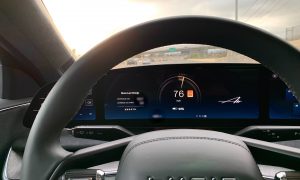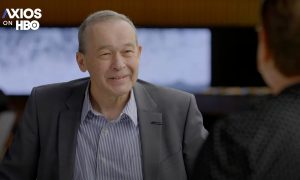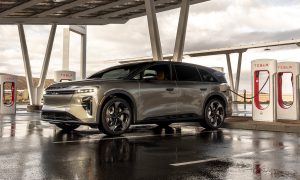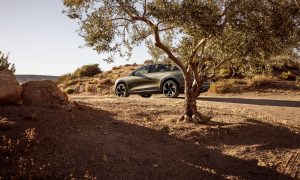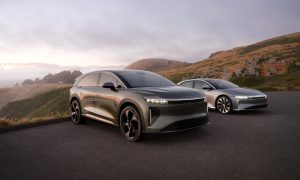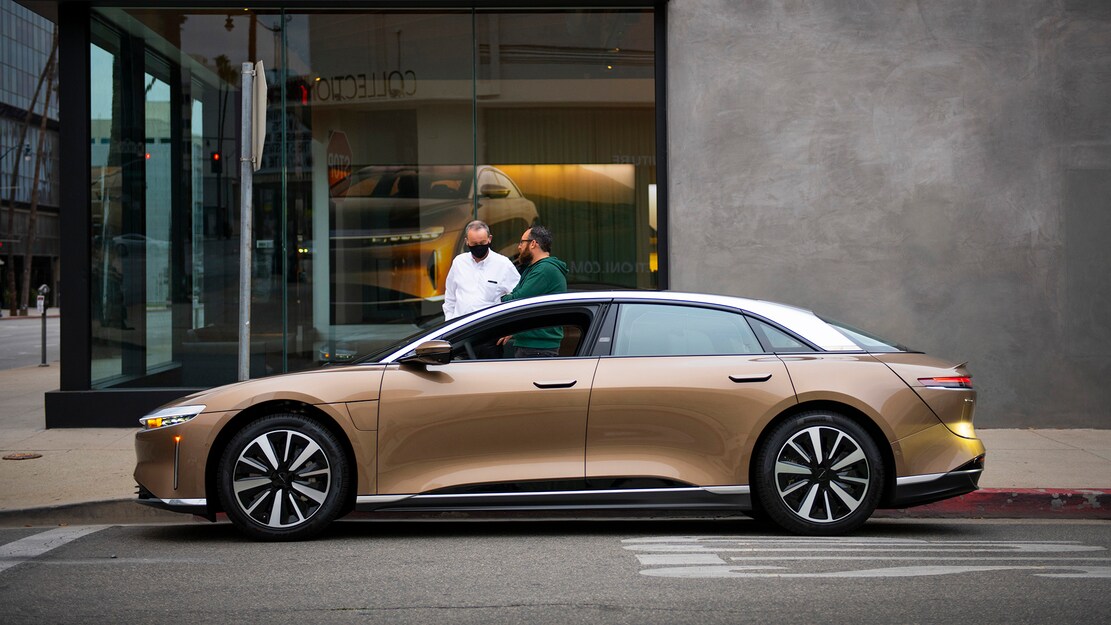

News
The Lucid Air Dream Edition R’s first in-depth review reveals the car is a stunner
Lucid frontman Peter Rawlinson has spent plenty of years in the electric vehicle realm, so he definitely has an idea of what goes into creating a fast, luxurious, and effective electric car. Prior to his time at Lucid, Rawlinson was one of the key members of Tesla’s Model S development team back in the early 2010s, before leaving the company to pursue his own interests, eventually landing at Lucid Motors. As the electric vehicle sector continues to develop quite nicely in the grand scheme of things, with both exclusively electric companies and legacy automakers all contributing to the sustainable energy transition, Lucid is set to deliver its first vehicle, the Air Dream Edition sedan, later this year, and Motortrend got an in-depth and exclusive look at the car that could quite possibly be the king of the hill when it enters the market.
Design
One of the sharpest vehicles in the automotive sector, the Air Dream Edition was outfitted in Eureka Gold for this breakdown by Motortrend. Reminiscent of the Citroën DS redesigned for Blade Runner, the car is simple yet futuristic in its design. It’s a long sedan, and in photographs almost reminds me of an older Ford Taurus in its “boaty” nature. However, it is much more pleasing to the eye, in my opinion. (The Ford Taurus was my second car. I drove it to class in college, and Lord, I hated that thing.)
Credit: MotorTrend
Sleek and luxurious, the reviewers were more particular to this interior than that of the Tesla Model S, stating that “every Tesla since day one has seemingly shipped without a finished interior, Lucid not only crafted a perfectly wonderful luxury-car cabin, but it also smartly avoided the screens über alles aesthetic that plagues cars like the Mercedes EQS.” Truth is, the Air interior is still relatively simplistic, and while it does have a few more bells and whistles than the Tesla Model S, it is not all that different other than an extended instrument cluster, a repositioned center screen, and more material options.
Credit: MotorTrend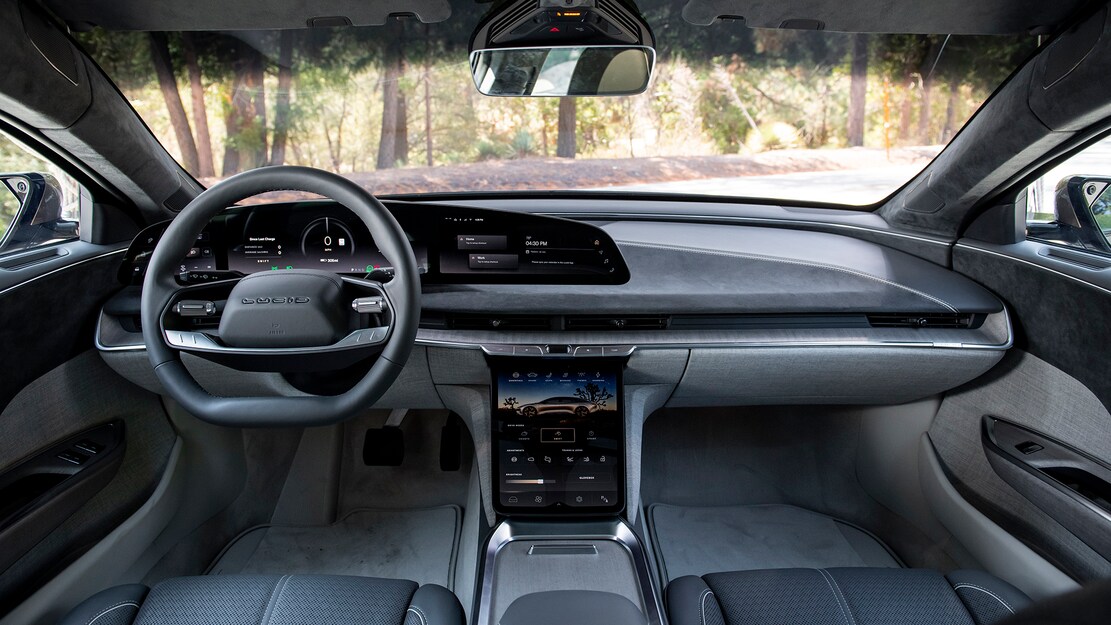
Performance
The Air Dream does not drive like a Lotus, which Rawlinson wanted when he designed the car: the look of a Mercedes with the ride of a Lotus. In fact, Jonny Lieberman, who wrote MotorTrend’s review, said it’s more like a Nissan GT-R. It has great handling, and with 933 horsepower, it’s extremely quick. Couple these performance tidbits based on Lieberman’s experience with the already stunning design and comfortable interior, and you have a car that is sure to appeal to many.
Carving turns in the Air was one of the highlights of the test drive. “I assumed the Air Dream Edition R would be decent enough to drive around big sweepers, but about 10 miles into our run up Angeles Crest Highway, I discovered the car enjoyed being manhandled through tight corners,” Lieberman wrote. The harder he drove the car, the better it performed, making it an ideal choice for a scenic joyride through winding and curvy rods, especially with the all-wheel-drive system to help navigate through those corners.
Not only is the car fun to drive, but it’s fast too, even if it’s over 5,000 pounds. Impressive with this pre-production Air model that was available for the test drive, the car will only improve as Lucid begins cranking out production models of the vehicle soon. This is where Lieberman expects Lucid to improve on an already great car. The front end seemed to be a little too free for his liking, while the back tires provided sufficient grip and maneuverability through tight corners. According to Lucid’s Director of Chassis and Vehicle Dynamics David Lickfold, the front spring rate will be reduced by 10% before production begins. The anti-roll bar will be stiffened for more support and stability, and active dampers will get an adjustment, too, providing an even smoother ride than already given.
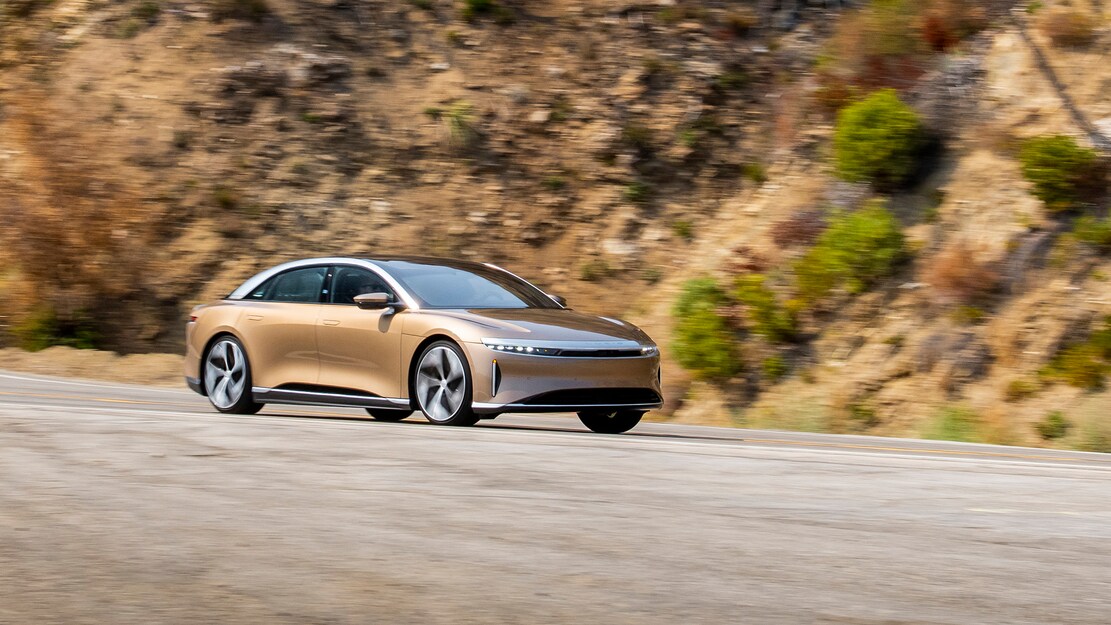
Credit: Motortrend
Three Drive Modes
The Air will come with three available drive modes, as Lickfold was curious about the condition of the roads that the Air was being tested on by MotorTrend. He suggested Lieberman leave it in Swift Mode, the second option, between Smooth and Sprint.
- Smooth Mode: Motors limited to 670 horsepower, softens dampers and brake pedal feel, the steering wheel is “free” feeling
- Swift Mode: Motors limited to 670 horsepower, much firmer feel than smooth mode, suitable for quicker driving on winding roads, but still holding back some performance
- Sprint Mode: Motors can reach full 933 horsepower potential, dampers are very hard, extremely sporty driving feel with “Tesla Plaid-like battery conditioning” for battery performance
Swift Mode brings out about 75% of the total power output, according to Emad Dlala, Lucid’s Senior Director of Efficiency and Energy Technology.
Credit: MotorTrend
Efficiency, Range, Battery Pack
The Air Dream Edition R is supposed to have 500 miles of range at a minimum, and the EPA will either confirm or deny this when it certifies the car in the coming months. MotorTrend decided to test the range on its own terms with a drive from Los Angeles to San Francisco, close to 350 miles. Not only did this drive provide some insight on how the range of the vehicle would be, but it would also give the reviewers an opportunity to get a look at what the vehicle would be like in its most frequent way of travel: abiding by speed limits and traffic rules during highways, while having to navigate through traffic and provide the driver and passengers with safety, but also entertainment and comfortability through the lengthy quest up the California coast.
It’s a smooth ride, there was wind noise, a common complaint among EVs due to their lack of an engine to drown out road sounds, but tire noise was minimal, Lieberman said. The car sat on Pirelli P Zeros, specifically designed for Lucid. After 205 miles of driving, the range of the vehicle had gone from 503 miles to 286, so there was slightly more energy usage through the 205 miles of driving as 217 miles had been subtracted from the range since the start of the trip. The additional range usage was due to air conditioning, so Lieberman adjusted the temperature from 69 to 71 to see if there was any impact.
The team arrived in San Francisco with 69 miles of range remaining, not needing to charge up at any point during the drive.
Credit: Motortrend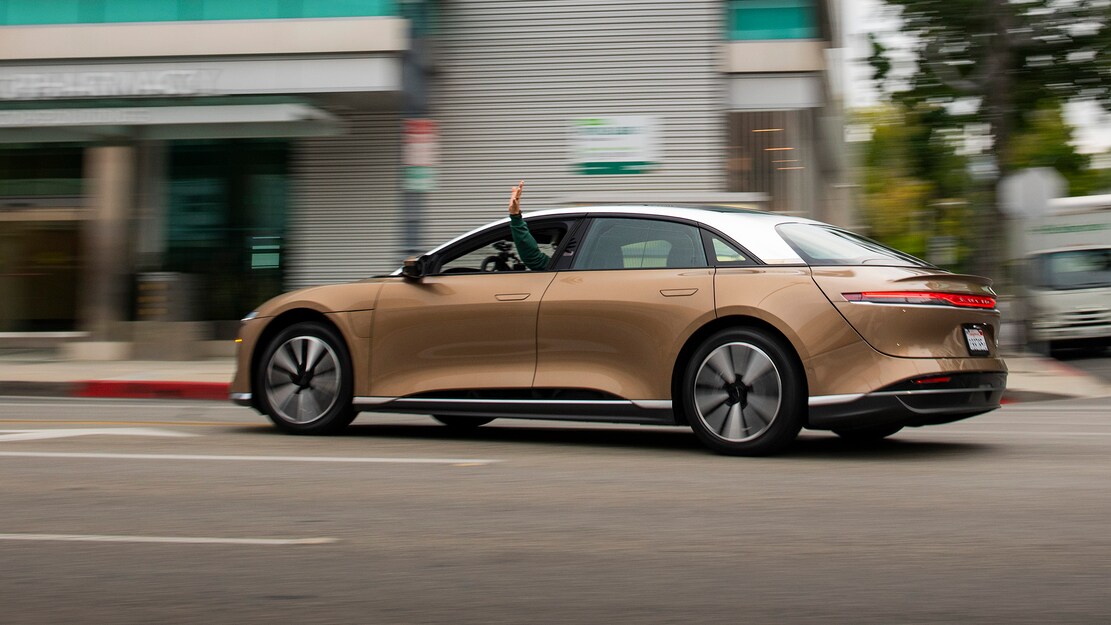
While Lucid still remains very vague in terms of when the Air Dream Edition will begin deliveries, the company still expects them to occur this year. With its unique design, different drive modes, impressive range, fast performance, and sporty but luxury interior, the car is certainly one of the most-anticipated EVs in the last several years. The car, along with Tesla’s vehicles, continues to chip away at the idea that range anxiety is an issue and EVs are not fast and fun. The Air is its own vehicle, and it’s important to not count it out before it hits the road, especially as Lieberman, who has reviewed hundreds of vehicles, was quite impressed by the Air Dream Edition.
Don’t hesitate to contact us with tips! Email us at tips@teslarati.com, or you can email me directly at joey@teslarati.com.
News
Tesla begins Robotaxi certification push in Arizona: report
Tesla seems serious about expanding its Robotaxi service to several states in the coming months.

Tesla has initiated discussions with Arizona transportation regulators to certify its driverless Robotaxi service in the state, as per a recent report from Bloomberg News. The move follows Tesla’s launch of its Robotaxi pilot program in Austin, Texas, as well as CEO Elon Musk’s recent comments about the service’s expansion in the Bay Area.
The Arizona Department of Transportation confirmed to Bloomberg that Tesla has reached out to begin the certification process for autonomous ride-sharing operations in the state. While details remain limited, the outreach suggests that Tesla is serious about expanding its driverless Robotaxi service to several territories in the coming months.
The Arizona development comes as Tesla prepares to expand its service area in Austin this weekend, as per CEO Elon Musk in a post on X. Musk also stated that Tesla is targeting the San Francisco Bay Area as its next major market, with a potential launch “in a month or two,” pending regulatory approvals.
Tesla first launched its autonomous ride-hailing program on June 22 in Austin with a small fleet of Model Y vehicles, accompanied by a Tesla employee in the passenger seat to monitor safety. While still classified as a test, Musk has said the program will expand to about 1,000 vehicles in the coming months. Tesla will later upgrade its Robotaxi fleet with the Cyercab, a two-seater that is designed without a steering wheel.
Sightings of Cybercab castings around the Giga Texas complex suggests that Tesla may be ramping the initial trial production of the self-driving two-seater. Tesla, for its part, has noted in the past that volume production of the Cybercab is expected to start sometime next year.
In California, Tesla has already applied for a transportation charter-party carrier permit from the state’s Public Utilities Commission. The company is reportedly taking a phased approach to operating in California, with the Robotaxi service starting with pre-arranged rides for employees in vehicles with safety drivers.
News
Tesla sets November 6 date for 2025 Annual Shareholder Meeting
The automaker announced the date on Thursday in a Form 8-K.

Tesla has scheduled its 2025 annual shareholder meeting for November 6, addressing investor concerns that the company was nearing a legal deadline to hold the event.
The automaker announced the date on Thursday in a Form 8-K submitted to the United States Securities and Exchange Commission (SEC). The company also listed a new proposal submission deadline of July 31 for items to be included in the proxy statement.
Tesla’s announcement followed calls from a group of 27 shareholders, including the leaders of large public pension funds, which urged Tesla’s board to formally set the meeting date, as noted in a report from The Wall Street Journal.
The group noted that under Texas law, where Tesla is now incorporated, companies must hold annual meetings within 13 months of the last one if requested by shareholders. Tesla’s previous annual shareholder meeting was held on June 13, 2024, which placed the July 13 deadline in focus.
Tesla originally stated in its 2024 annual report that it would file its proxy statement by the end of April. However, an amended filing on April 30 indicated that the Board of Directors had not yet finalized a meeting date, at least at the time.
The April filing also confirmed that Tesla’s board had formed a special committee to evaluate certain matters related to CEO Elon Musk’s compensation plan. Musk’s CEO performance award remains at the center of a lengthy legal dispute in Delaware, Tesla’s former state of incorporation.
Due to the aftermath of Musk’s legal dispute about his compensation plan in Delaware, he has not been paid for his work at Tesla for several years. Musk, for his part, has noted that he is more concerned about his voting stake in Tesla than his actual salary.
At last year’s annual meeting, TSLA shareholders voted to reapprove Elon Musk’s compensation plan and ratified Tesla’s decision to relocate its legal domicile from Delaware to Texas.
Elon Musk
Grok coming to Tesla vehicles next week “at the latest:” Elon Musk
Grok’s rollout to Tesla vehicles is expected to begin next week at the latest.

Elon Musk announced on Thursday that Grok, the large language model developed by his startup xAI, will soon be available in Tesla vehicles. Grok’s rollout to Tesla vehicles is expected to begin next week at the latest, further deepening the ties between the two Elon Musk-led companies.
Tesla–xAI synergy
Musk confirmed the news on X shortly after livestreaming the release of Grok 4, xAI’s latest large language model. “Grok is coming to Tesla vehicles very soon. Next week at the latest,” Musk wrote in a post on social media platform X.
During the livestream, Musk and several members of the xAI team highlighted several upgrades to Grok 4’s voice capabilities and performance metrics, positioning the LLM as competitive with top-tier models from OpenAI and Google.
The in-vehicle integration of Grok marks a new chapter in Tesla’s AI development. While Tesla has long relied on in-house systems for autonomous driving and energy optimization, Grok’s integration would introduce conversational AI directly into its vehicles’ user experience. This integration could potentially improve customer interaction inside Tesla vehicles.
xAI and Tesla’s collaborative footprint
Grok’s upcoming rollout to Tesla vehicles adds to a growing business relationship between Tesla and xAI. Earlier this year, Tesla disclosed that it generated $198.3 million in revenue from commercial, consulting, and support agreements with xAI, as noted in a report from Bloomberg News. A large portion of that amount, however, came from the sale of Megapack energy storage systems to the artificial intelligence startup.
In July 2023, Musk polled X users about whether Tesla should invest $5 billion in xAI. While no formal investment has been made so far, 68% of poll participants voted yes, and Musk has since stated that the idea would be discussed with Tesla’s board.
-

 Elon Musk1 week ago
Elon Musk1 week agoTesla investors will be shocked by Jim Cramer’s latest assessment
-

 Elon Musk3 days ago
Elon Musk3 days agoElon Musk confirms Grok 4 launch on July 9 with livestream event
-

 Elon Musk16 hours ago
Elon Musk16 hours agoxAI launches Grok 4 with new $300/month SuperGrok Heavy subscription
-

 News7 days ago
News7 days agoTesla Model 3 ranks as the safest new car in Europe for 2025, per Euro NCAP tests
-

 Elon Musk2 weeks ago
Elon Musk2 weeks agoA Tesla just delivered itself to a customer autonomously, Elon Musk confirms
-

 Elon Musk1 week ago
Elon Musk1 week agoxAI’s Memphis data center receives air permit despite community criticism
-

 Elon Musk2 weeks ago
Elon Musk2 weeks agoTesla’s Omead Afshar, known as Elon Musk’s right-hand man, leaves company: reports
-

 News2 weeks ago
News2 weeks agoXiaomi CEO congratulates Tesla on first FSD delivery: “We have to continue learning!”


